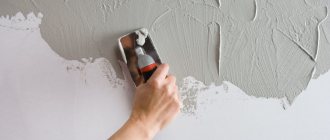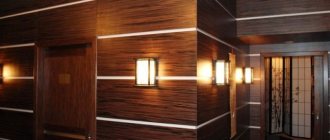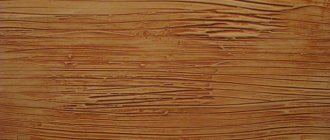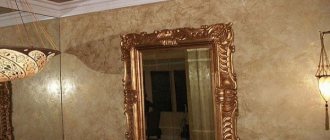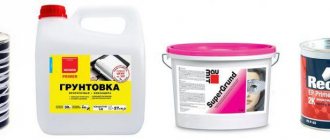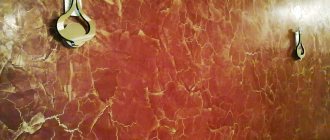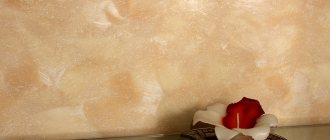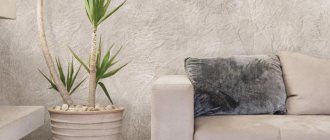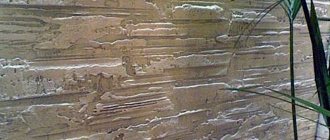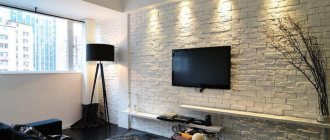Correggio decorative plaster from Art Deco allows you to create the effect of delicate velvet. It consists of pearlescent pigment, acrylic binders and special additives. Thanks to its texture and composition, Correggio helps to hide small defects in walls. Therefore, surface preparation may not be as thorough as with other decorative materials. So you don’t have to worry that unevenness and scratches will appear after applying the grout.
The high elasticity of Correggio makes it convenient to use not only for masters of the craft, but also for amateurs. Decorative plaster Art Deco Correggio is sold in the following basic shades:
- Gold
- White gold
- Silver
Even though we're talking about a water-based material, it's moisture-resistant, so it can easily handle cleaning with a damp cloth. Surface preparation is standard: clean from dirt and grease, treat with a primer.
Depending on the application method, the plaster is diluted with water in different proportions. You can dilute the solution with water by 10%. After this, it is applied with a trowel or spatula in two layers. The interval between applications is 6 hours. In both cases, multidirectional or circular movements are performed. You can also dilute the solution with water by 20%, but after that it will have to be applied with a roller. In this case, the surface should also be leveled with circular or multidirectional movements, creating the desired pattern.
You need to work at an air temperature of +5C°-+35C°, with an air humidity of no more than 80%. If you need to wait up to 6 hours between applying layers for the decorative plaster to dry, then complete drying of the solution occurs after 7 days. One kilogram of Correggio is enough to process 5-6 sq.m. Of course, the exact consumption depends on the thickness of the applied solution.
Three videos provide techniques for applying decorative plaster Art Deco Correggio: classic velvet, antique silk and textured using a sponge.
How to achieve a velvet effect?
The process of applying velvet effect plaster is somewhat more complicated than the conventional method. This work is performed mainly by specialists. After all, the coating is a mixture of paint and plaster in a certain consistency .
The tool with which the mixture is applied to the wall contains two components at once - the plaster itself and the paint. They are applied simultaneously. But with a little skill, you can master the technique of applying plaster: the main thing is that the material and tools are selected correctly.
Preparing the base
To prepare the base you need:
- Examine the surfaces for unevenness or other problems: areas with peeling plaster, holes from dowels.
- If there are any, they need to be eliminated. The plaster is cleaned and an additional layer is applied if necessary. Relief areas are sanded.
- Afterwards, you need to completely clean the surface from dust and treat it with a primer.
- When the primer has dried, level the walls with putty. Different surfaces are puttied differently.
- Use masking tape to protect decorative elements that you do not plan to paint.
- Cover the finished base with acrylic primer. This will improve adhesion to the coloring material.
Dye
Photo
Below are photos of the walls after finishing.
How to add luxury to the interior
To provide a house or apartment with luxury, you will need to carry out preparatory work with cleaning the walls and priming. The result of decorating depends on proper preparation and following instructions.
It is not advisable to apply paint to surfaces that are affected by fungus or mold, or are too uneven. You should first plaster and level the walls. Afterwards you can start painting.
In addition to the coloring itself, an important stage is the choice of accessories. Materials that imitate natural ones require the use of additional decorative items that complement the picture.
Matte option
Color selection
Attention
Special paint with a velvet effect for plaster is sold at all construction markets and in large stores. There are domestic and foreign brands. Their quality and consistency are usually the same, but domestic paint is cheaper than its imported counterpart. The paint is mostly water-based and usually white in color.
You can change the shade by adding a colored pigment to the base. In total there are more than 300 shades, the customer will be able to implement any of his solutions for decorating the walls. However, there are some recommendations. For example:
- for offices it is proposed to use calm tones;
- for apartments - cozy, warm;
- and for children's rooms, on the contrary, bright and rich colors.
What materials are needed?
There may be several types of coverage:
- Texture (velvet relief).
- Structural.
- Venetian plaster, characterized by increased smoothness. A master with experience will be able to work with it.
The remaining types differ in the composition of the binding element.
To prepare surfaces, special primer solutions are needed to treat walls before plastering. Sometimes you may need a concrete mixture to seal large cracks in the walls and level the wall itself.
Step-by-step application instructions
A velvet surface can be obtained by following the instructions:
- First the paint is prepared. If it has been standing in a store or warehouse for a long time, the composition settles and a sediment forms in the jar. Shake or stir the jar of paint well.
- Color dye and 10–20% water are added to the container, everything is thoroughly mixed.
- At the third stage, putty and paint are applied to the walls, starting with hard-to-reach places. For example, around windows, doors, in corners, etc. You need to paint with a brush with a working part width of no more than 3 cm.
- After painting the corners and slopes, the remaining walls are painted. It is applied with a velor roller. This must be done carefully, but with skill, so that there are no smudges or empty unpainted areas.
- In order for the paint layer to lay down evenly, the roller must be rolled out on a special tray with paint. Otherwise, areas with too thin or thick layers may appear on the wall.
- Paint applied according to all rules dries completely in 24–36 hours. The exact time, taking into account the ambient temperature, is indicated on the can.
- After the background paint layer has dried, putty is applied to the walls using a trowel. The mixture is applied in a small portion to its working part and smoothed evenly over the wall.
Advice
To enhance the effect of a velvet wall, you need to repeat the process of applying putty with another layer.
Paint Features
Paintwork with the effect of velvet drapery is an unusual wall covering that resembles expensive fabric and makes the interior of the house interesting and rich. This paint is prepared on the basis of acrylic or latex water emulsion and additionally contains particles of quartz sand and mother-of-pearl. After application to the wall, a play of light occurs, its flows dissipate, resulting in the illusion of a soft, fluffy paint film.
Velvet paint is used in a special way. It often consists of two main components - a primer and a topcoat containing microparticles, although single-component products are also sold. As the layers dry, a special texture of the paint appears. If you compare the material with conventional textiles for wall upholstery, you can see many advantages:
- long service life without loss of attractiveness and properties;
- ease of use in everyday life, the possibility of wet cleaning and the use of detergents;
- resistance to UV radiation and temperature changes;
- harmless to health, no unpleasant odor, ability to work in the house without a respirator;
- short drying period and minimal time;
- suitability for various building substrates - concrete, brick, plaster, drywall, etc.;
- the ability to hide surface defects - irregularities, seams, joints;
- tinting compositions in any color, selecting shades for different types of interior design;
- high quality coating, no cracking, peeling, or shedding over time.
Advice from the experts
To successfully apply decorative putty, craftsmen advise not to skimp on materials, especially on paint and varnish coating . It must be of high quality. There are also a number of recommendations from professionals that make sense to listen to:
- You should never be afraid of working with a special tool: your hands get used to it very quickly. Even a beginner can easily paint walls with a roller or brush in half an hour or an hour.
- The second useful tip is to always read the instructions on the package or jar. Everything is written there - how to dilute the composition, how long it takes to dry, how to apply it, sometimes it is even written what tool is used to carry out the work.
- If the type of decorative plaster involves layer-by-layer installation, then apply the mixture one by one only after the previous layer has completely dried. Yes, it may take several days, but the result will exceed expectations.
- You can give the desired texture to the plaster not only with a trowel with teeth around the perimeter. This work can be done with a regular sponge, brush, broom, or even a patterned roller. These tools are used to create drawings, patterns, transitions, and structures.
- The structure of the plaster composition can be changed within several hours after its application, until it has completely hardened. Once it dries, this cannot be done.
- To save material, and it can be very expensive, all unevenness in the base can be leveled with cheap material. And then apply a decorative composition with various additives to it.
- When choosing a color, take into account that after the paint dries, its tone becomes a little lighter.
- When calculating the amount of paint, plaster and even color additives, you need to calculate their amount for all walls for finishing with a small margin. After all, if the paint, plaster or color scheme runs out during the work process, then it will not be possible to make exactly the same mixture. It will be difficult to find exactly this color on the market. The surface will look uneven. Patches of a different shade will appear on it.
Application methods
To apply the coating correctly, the surface must be carefully prepared. Conditions must be met:
- Air temperature from 5 to 35 degrees Celsius.
- Relative humidity below 75%. The optimal value is 60%.
Dilute the paint with water in the proportions recommended by the manufacturer. Add color according to the manufacturer's catalog. Stir the mixture until the color is uniform. Apply a thick layer with a paint brush, spreading evenly.
Color schemes
A few minutes after application, begin to smooth it with a trowel in different directions. Afterwards, a velvet effect will appear on the surface. Move the trowel parallel to the base so as not to tear off the paint. If the paint is erased, apply additional paint and continue smoothing.
Interior options
The interior can be anything you want. The decorative plaster coating even has specific names used among designers - these are “Lamb”, “Fur Fur”, “Bark Beetle” and others. They differ in layer thickness and texture.
The choice of color is left to the customer’s choice, but it must take into account the purpose of the room.
- For bedrooms, choose calm, cream, beige or dark red tones.
- For living rooms - brighter colors, for example, blue or green.
- Light beige or ivory are suitable for office decoration.
Types of material
Decorative plaster is not limited to the velvet effect.
- The already mentioned Venetian style, whose structure resembles a smooth marble coating, changes its shade when the angle of light changes. This is due to the translucency of the coating layer. The color can be anything, because marble comes in different shades. But this coating is more suitable for formal rooms, living rooms, and offices. In bedrooms and children's rooms, pretentious marble walls are undesirable.
- There is also a material with a mother-of-pearl effect - “Ottocento la seta”. The composition includes acrylic paints diluted with water. Colors are chosen from a variety of shades.
- “Imperiale or Damasco” is a covering with a fabric effect, when the walls seem to be covered with silk. But applying such a layer is very difficult, so only experienced craftsmen can do it. It is unlikely that you will be able to make such a cladding yourself.
- Another fabric covering layer is called Antico Velluto. It differs from the previous one in more expensive material.
Venetian decorative plaster
Speaking about this amazing material, one cannot help but highlight one of the first in this series: Venetian decorative plaster - also known as Venetian, this is far from a new finishing material. Of course, the modern composition differs from the composition that was used in the Roman Empire, but its basis, marble dust, has remained unchanged. Later, during the Renaissance in Venice, it received its rebirth and has since been used throughout the world.
Black marble decorative plaster is a coating that imitates old decoration methods
As a result of layer-by-layer application of the Venetian with a special tool - a trowel and its subsequent polishing, a smooth and pleasant to the touch surface is obtained, giving the surrounding space an individual character.
The most common options allow you to achieve the appearance of marble, wet or worn silk and aged velor velvet, corduroy . One type of Venetian plaster is Moroccan plaster . Morocco's distinctive feature is the use of more layers and the presence of a golden glow in its texture.
Classic Venetian decorative plaster is a completely environmentally friendly product that is produced on the basis of natural ingredients. Made from marble dust and slaked lime. The basis of the original recipe has been passed down from generation to generation. Although many modern Venetian women do not have lime in their composition, the binder is acrylic. The use of this product allows you to remove moisture from the walls, suppressing the growth of fungi and mold, making the indoor microclimate safe.
Work prices
For those owners who fully pay for the work of the craftsmen and do not try to do something on their own, you need to know the prices. The material is sold in stores and on the market at stable prices. The higher the quality of the material, the higher the price.
Important
The price of the work can be calculated taking into account the area of the base. It is 400-800 rubles. per square meter, depends on the skill of the worker and the cost of the material.
Velvet decorative plaster has a high cost, but it is still popular because it creates an indescribable feeling of coziness and comfort in the room.
